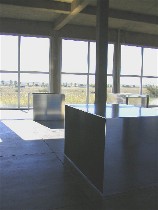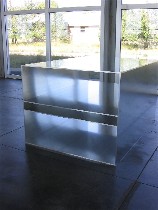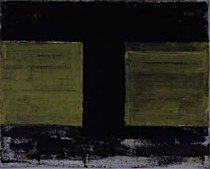Post from Douglas T. Witmer, Part II

[Editor’s note: This is the second part of Witmer’s abstraction post that ran Dec. 18.]
I recently had the chance to visit Donald Judd’s Chinati Foundation in Marfa, TX. …My wife and baby and I were in with a group of about a dozen other folks, most of whom were more tourists than gallery-goers. I was unprepared for what happened.
The guide took us to the hangers where Judd’s 100 aluminum boxes are installed and said only, “Donald Judd renovated these buildings so he could install his boxes here. The boxes are made of aluminum and the exterior dimensions are the same, but they are all different in their interiors.” No theory, no dates, no context.
 And then he unlocked the doors and we went inside and for the next 20 minutes we were suddenly all together, walking around in a quiet visual wonderworld.
And then he unlocked the doors and we went inside and for the next 20 minutes we were suddenly all together, walking around in a quiet visual wonderworld.
I eavesdropped a bit on the others’ conversations, and to a person they were simply dealing with the elements of the experience at hand, looking at the properties of the boxes, looking at their relationship to the vast landscape just outside the floor-to-ceiling windows–clearly engaged and enjoying the process.
The experience flew in the face what I know of the conventional artworld buzz on Judd–chilly, reasoned, minimal.
 An idea that has been trying to come up for air in this little essay is that of a search for a kind of purity. It does not necessarily mean an exclusive or restrictive state, but rather simply a focused experience. This is what much abstraction does. It does not seek to mirror or narrate our “cyber-warrior culture and civilization-clash world.” It can still have contemporay relevance by being, as the artist Helmut Federle has said, “a clear alternative to the zeitgeist and velocity of modern life (shown, a painting from Federle’s Black Series).”
An idea that has been trying to come up for air in this little essay is that of a search for a kind of purity. It does not necessarily mean an exclusive or restrictive state, but rather simply a focused experience. This is what much abstraction does. It does not seek to mirror or narrate our “cyber-warrior culture and civilization-clash world.” It can still have contemporay relevance by being, as the artist Helmut Federle has said, “a clear alternative to the zeitgeist and velocity of modern life (shown, a painting from Federle’s Black Series).”









